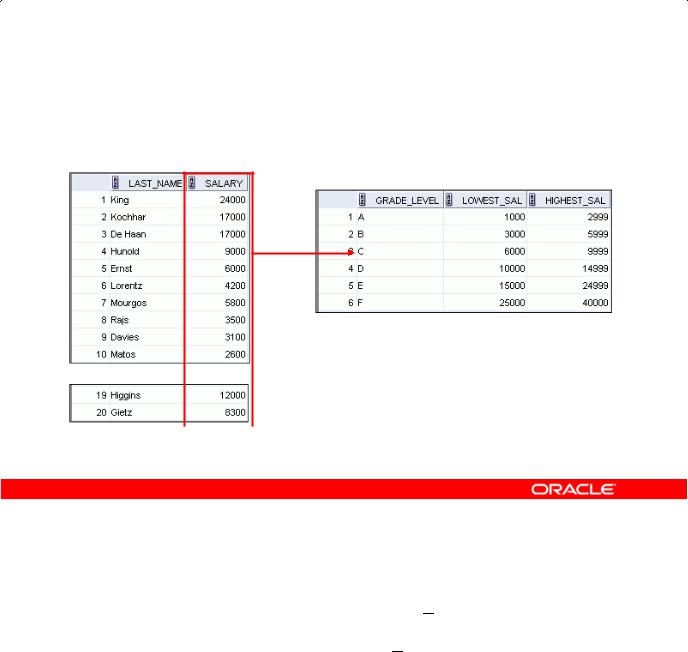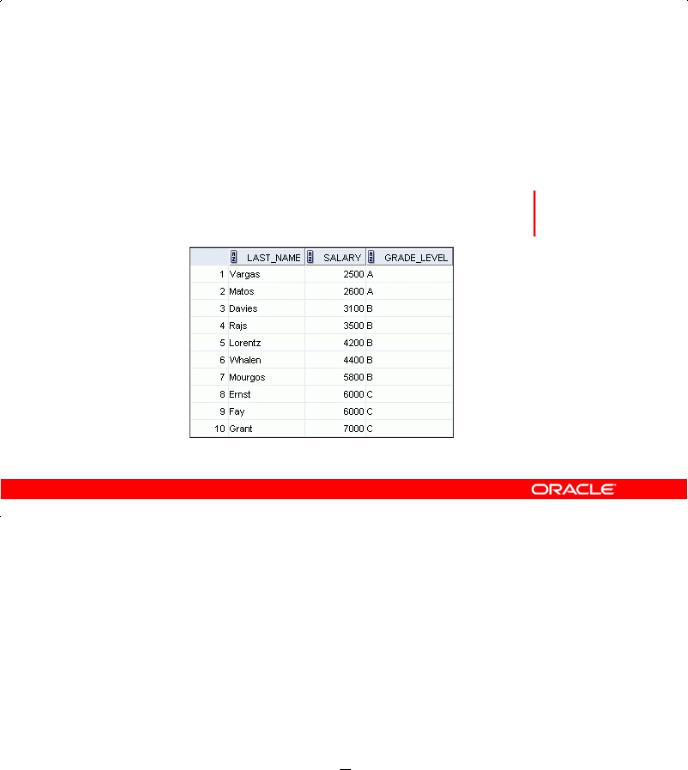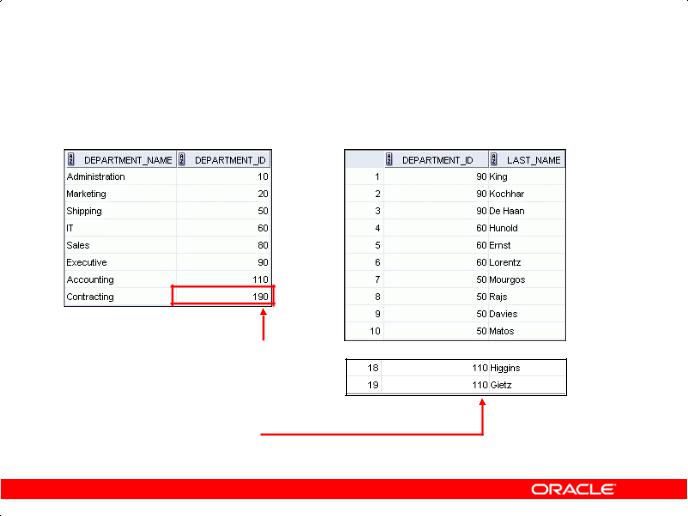
- •Preface
- •Introduction
- •Lesson Objectives
- •Lesson Agenda
- •Course Objectives
- •Course Agenda
- •Appendixes Used in the Course
- •Lesson Agenda
- •Oracle Database 11g: Focus Areas
- •Oracle Database 11g
- •Oracle Fusion Middleware
- •Oracle Enterprise Manager Grid Control 10g
- •Oracle BI Publisher
- •Lesson Agenda
- •Relational and Object Relational Database Management Systems
- •Data Storage on Different Media
- •Relational Database Concept
- •Definition of a Relational Database
- •Data Models
- •Entity Relationship Model
- •Relating Multiple Tables
- •Relational Database Terminology
- •Lesson Agenda
- •Using SQL to Query Your Database
- •SQL Statements
- •Development Environments for SQL
- •Lesson Agenda
- •The Human Resources (HR) Schema
- •Tables Used in the Course
- •Lesson Agenda
- •Oracle Database 11g Documentation
- •Additional Resources
- •Summary
- •Practice I: Overview
- •Objectives
- •Lesson Agenda
- •Capabilities of SQL SELECT Statements
- •Basic SELECT Statement
- •Selecting All Columns
- •Selecting Specific Columns
- •Writing SQL Statements
- •Column Heading Defaults
- •Lesson Agenda
- •Arithmetic Expressions
- •Using Arithmetic Operators
- •Operator Precedence
- •Defining a Null Value
- •Null Values in Arithmetic Expressions
- •Lesson Agenda
- •Defining a Column Alias
- •Using Column Aliases
- •Lesson Agenda
- •Concatenation Operator
- •Literal Character Strings
- •Using Literal Character Strings
- •Alternative Quote (q) Operator
- •Duplicate Rows
- •Lesson Agenda
- •Displaying the Table Structure
- •Using the DESCRIBE Command
- •Quiz
- •Summary
- •Practice 1: Overview
- •Objectives
- •Lesson Agenda
- •Limiting Rows Using a Selection
- •Limiting the Rows That Are Selected
- •Using the WHERE Clause
- •Character Strings and Dates
- •Comparison Operators
- •Using Comparison Operators
- •Range Conditions Using the BETWEEN Operator
- •Membership Condition Using the IN Operator
- •Pattern Matching Using the LIKE Operator
- •Combining Wildcard Characters
- •Using the NULL Conditions
- •Defining Conditions Using the Logical Operators
- •Using the AND Operator
- •Using the OR Operator
- •Using the NOT Operator
- •Lesson Agenda
- •Rules of Precedence
- •Lesson Agenda
- •Using the ORDER BY Clause
- •Sorting
- •Lesson Agenda
- •Substitution Variables
- •Using the Single-Ampersand Substitution Variable
- •Character and Date Values with Substitution Variables
- •Specifying Column Names, Expressions, and Text
- •Using the Double-Ampersand Substitution Variable
- •Lesson Agenda
- •Using the DEFINE Command
- •Using the VERIFY Command
- •Quiz
- •Summary
- •Practice 2: Overview
- •Objectives
- •Lesson Agenda
- •SQL Functions
- •Two Types of SQL Functions
- •Single-Row Functions
- •Lesson Agenda
- •Character Functions
- •Case-Conversion Functions
- •Using Case-Conversion Functions
- •Character-Manipulation Functions
- •Using the Character-Manipulation Functions
- •Lesson Agenda
- •Number Functions
- •Using the ROUND Function
- •Using the TRUNC Function
- •Using the MOD Function
- •Lesson Agenda
- •Working with Dates
- •RR Date Format
- •Using the SYSDATE Function
- •Arithmetic with Dates
- •Using Arithmetic Operators with Dates
- •Lesson Agenda
- •Date-Manipulation Functions
- •Using Date Functions
- •Using ROUND and TRUNC Functions with Dates
- •Quiz
- •Summary
- •Practice 3: Overview
- •Objectives
- •Lesson Agenda
- •Conversion Functions
- •Implicit Data Type Conversion
- •Explicit Data Type Conversion
- •Lesson Agenda
- •Using the TO_CHAR Function with Dates
- •Elements of the Date Format Model
- •Using the TO_CHAR Function with Dates
- •Using the TO_CHAR Function with Numbers
- •Using the TO_NUMBER and TO_DATE Functions
- •Using the TO_CHAR and TO_DATE Function with RR Date Format
- •Lesson Agenda
- •Nesting Functions
- •Lesson Agenda
- •General Functions
- •NVL Function
- •Using the NVL Function
- •Using the NVL2 Function
- •Using the NULLIF Function
- •Using the COALESCE Function
- •Lesson Agenda
- •Conditional Expressions
- •CASE Expression
- •Using the CASE Expression
- •DECODE Function
- •Using the DECODE Function
- •Quiz
- •Summary
- •Practice 4: Overview
- •Objectives
- •Lesson Agenda
- •What Are Group Functions?
- •Types of Group Functions
- •Group Functions: Syntax
- •Using the AVG and SUM Functions
- •Using the MIN and MAX Functions
- •Using the COUNT Function
- •Using the DISTINCT Keyword
- •Group Functions and Null Values
- •Lesson Agenda
- •Creating Groups of Data
- •Creating Groups of Data: GROUP BY Clause Syntax
- •Using the GROUP BY Clause
- •Grouping by More than One Column
- •Using the GROUP BY Clause on Multiple Columns
- •Illegal Queries Using Group Functions
- •Restricting Group Results
- •Restricting Group Results with the HAVING Clause
- •Using the HAVING Clause
- •Lesson Agenda
- •Nesting Group Functions
- •Quiz
- •Summary
- •Practice 5: Overview
- •Objectives
- •Lesson Agenda
- •Types of Joins
- •Joining Tables Using SQL:1999 Syntax
- •Qualifying Ambiguous Column Names
- •Lesson Agenda
- •Creating Natural Joins
- •Retrieving Records with Natural Joins
- •Creating Joins with the USING Clause
- •Joining Column Names
- •Retrieving Records with the USING Clause
- •Using Table Aliases with the USING Clause
- •Creating Joins with the ON Clause
- •Retrieving Records with the ON Clause
- •Creating Three-Way Joins with the ON Clause
- •Applying Additional Conditions to a Join
- •Lesson Agenda
- •Joining a Table to Itself
- •Self-Joins Using the ON Clause
- •Lesson Agenda
- •Nonequijoins
- •Retrieving Records with Nonequijoins
- •Lesson Agenda
- •INNER Versus OUTER Joins
- •LEFT OUTER JOIN
- •RIGHT OUTER JOIN
- •FULL OUTER JOIN
- •Lesson Agenda
- •Cartesian Products
- •Generating a Cartesian Product
- •Creating Cross Joins
- •Quiz
- •Summary
- •Practice 6: Overview
- •Objectives
- •Lesson Agenda
- •Using a Subquery to Solve a Problem
- •Subquery Syntax
- •Using a Subquery
- •Guidelines for Using Subqueries
- •Types of Subqueries
- •Lesson Agenda
- •Single-Row Subqueries
- •Executing Single-Row Subqueries
- •Using Group Functions in a Subquery
- •The HAVING Clause with Subqueries
- •What Is Wrong with This Statement?
- •No Rows Returned by the Inner Query
- •Lesson Agenda
- •Multiple-Row Subqueries
- •Lesson Agenda
- •Null Values in a Subquery
- •Quiz
- •Summary
- •Practice 7: Overview
- •Objectives
- •Lesson Agenda
- •Set Operators
- •Set Operator Guidelines
- •The Oracle Server and Set Operators
- •Lesson Agenda
- •Tables Used in This Lesson
- •Lesson Agenda
- •UNION Operator
- •Using the UNION Operator
- •UNION ALL Operator
- •Using the UNION ALL Operator
- •Lesson Agenda
- •INTERSECT Operator
- •Using the INTERSECT Operator
- •Lesson Agenda
- •MINUS Operator
- •Using the MINUS Operator
- •Lesson Agenda
- •Matching the SELECT Statements
- •Matching the SELECT Statement: Example
- •Lesson Agenda
- •Using the ORDER BY Clause in Set Operations
- •Quiz
- •Summary
- •Practice 8: Overview

Lesson Agenda
•Types of JOINS and its syntax
•Natural join:
–USING clause
–ON clause
•Self-join
•Nonequijoins
•OUTER join:
–LEFT OUTER join
–RIGHT OUTER join
–FULL OUTER join
•Cartesian product
–Cross join
|
Copyright © 2009, Oracle. All rights reserved. |
Academy |
||
|
|
|||
|
|
Oracle |
||
& |
Only |
|
||
|
Internal |
|
|
|
|
Use |
|
||
Oracle |
|
|
|
|
Oracle Database 11g: SQL Fundamentals I 6 - 22

Nonequijoins
EMPLOYEES |
JOB_GRADES |
|
|
|
|
|
|
|
|
… |
|
JOB_GRADES table defines the |
|
|
|
LOWEST_SAL and HIGHEST_SAL range |
||
|
|
|
of values for each GRADE_LEVEL. |
|
|
|
|
Hence, the GRADE_LEVEL column can |
|
Nonequijoins |
|
be used to assign grades to each |
||
|
||||
|
employee. |
Academy |
||
|
|
|
|
|
|
|
Copyright © 2009, Oracle. All rights reserved. |
|
|
|
|
|
Oracle |
|
A nonequijoin is a join condition containing something other than an quality operator.
The relationship between the EMPLOYEES table and the JOB GRADES table is an example of a nonequijoin. The SALARY column in the EMPLOYEES t ble ranges between the values in the
LOWEST_SAL and HIGHEST_SAL columns of the J B GRADES table. Therefore, each employee |
||
|
|
Only |
can be graded based on their salary. The relationship is obtai ed using an operator other than the |
||
equality (=) operator. |
& |
|
Internal |
|
|
Oracle |
Use |
|
|
|
|
Oracle Database 11g: SQL Fundamentals I 6 - 23

Retrieving Records
with Nonequijoins
SELECT |
e.last_name, e.salary, j.grade_level |
|
FROM |
employees e JOIN job_grades j |
|
ON |
e.salary |
|
|
BETWEEN j.lowest_sal AND j.highest_sal; |
|
|
|
|
|
… |
|
|
Academy |
|
|
|
||
|
Copyright © 2009, Oracle. All rights reserved. |
|||
Retrieving Records with Nonequijoins |
||||
The slide example creates a nonequijoin to evaluate an employe ’s salary grade. The salary must be between any pair of the low and high salary ranges.
It is important to note that all employees appear exactly once when this query is executed. No |
|
employee is repeated in the list. There are two reasons for this: |
|
|
Oracle |
• None of the rows in the JOB_GRADES table contain grades that overlap. That is, the salary |
|
value for an employee can lie only between&the low salary and high salary values of one of the |
|
rows in the salary grade table. |
Only |
|
|
• All of the employees’ salaries lie within the limits provided by the job grade table. That is, no |
|
Note: Other conditio s (such as <= and >=) can be used, but BETWEEN is the simplest. Remember
employee earnsInternalless than the lowestUsevalue contained in the LOWEST_SAL column or more than the highest value con ain d in the HIGHEST SAL column.
to specify the low value first and the high value last when using the condition. The Oracle
Oracle BETWEEN
server trans at s the BETWEEN condition to a pair of AND conditions. Therefore, using BETWEEN has no performan e benefits, but should be used only for logical simplicity.
Table aliases have been specified in the slide example for performance reasons, not because of possible ambiguity.
Oracle Database 11g: SQL Fundamentals I 6 - 24

Lesson Agenda
•Types of JOINS and its syntax
•Natural join:
–USING clause
–ON clause
•Self-join
•Nonequijoins
•OUTER join:
–LEFT OUTER join
–RIGHT OUTER join
–FULL OUTER join
•Cartesian product
–Cross join
|
Copyright © 2009, Oracle. All rights reserved. |
Academy |
||
|
|
|||
|
|
Oracle |
||
& |
Only |
|
||
|
Internal |
|
|
|
|
Use |
|
||
Oracle |
|
|
|
|
Oracle Database 11g: SQL Fundamentals I 6 - 25

Returning Records with No Direct Match
Using OUTER Joins
Equijoin with EMPLOYEES
There are no employees in department 190.
Employee “Grant” has not been assigned a department ID.
Returning Records with No Direct Match Using OUTER JoinsAcademy
Copyright © 2009, Oracle. All rights reserved.
In the slide example, a simple equijoin condition is used on the EMPLOYEES and DEPARTMENTS tables to return the result on the right. The result set does not contain the following:
If a row does not satisfy a join condition, the rowOracledoes not appear in the query result.
• Department ID 190, because there are no employees with that department ID recorded in the |
|
EMPLOYEES table |
Only |
• The employee with the last name of Grant,&because this employee has not been assigned a |
|
Internal |
|
department ID |
|
Use |
|
To return the department reco d that does not have any employees, or employees that do not have an |
|
assigned department, you can use an O TER join. |
|
Oracle |
|
Oracle Database 11g: SQL Fundamentals I 6 - 26
